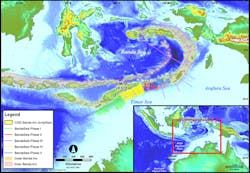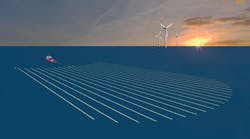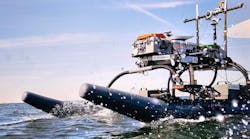CGG surveys de-risking frontier Asia/Pacific regions
CGG has completed work on JumpStart multi-client geoscience packages for Australia’s North West Shelf (NWS) and the Banda Arc in the Asia/Pacific region. Both are designed to assist assessment of emerging exploration plays.
The NWS JumpStart package encompasses the Northern Carnarvon, Roebuck, Browse and Bonaparte basins, where there have been recent Triassic discoveries.
According to CGG, the study sheds light on the region’s Triassic paleogeography and petroleum systems and mitigates exploration risk for Triassic plays. The Banda Arc JumpStart package covers a complex tectonic region at the collision zone between continental Australia and the Indonesian archipelago where there has previously been little data available.
It uses new seismic data and interpretation from CGG’s 16,300-km (10,128-mi) BandaSeis 2D BroadSeis survey to address imaging challenges relating to the complex overburden and below the fold and thrust.
Elsewhere, CGG will deliver what it claims is the largest ocean bottom node (OBN) multi-client survey ever conducted in the UK central North Sea (CNS).
Planned to start in early 2020, the survey has received industry interest and is being prefunded in part by BP. First results are targeted for 1Q 2021.
In the first phase of this multi-year program, CGG aims to acquire more than 2,000 sq km (772 sq mi) of OBN data.
Complex salt diapirism in the CNS has created challenges to imaging deeper reservoir targets. According to the company, this new survey, with its long-offset, full-azimuth coverage and good low-frequency signal in a shallow water environment, together with its imaging technology, will provide a step-change in seismic image and reservoir characterization quality.
Polarcus acquiring Petrel broadband survey offshore Australia
Neptune Energy will receive new 3D seismic over the Petrel field in the Bonaparte basin offshore northwest Australia, under a non-exclusive data licensing agreement with Polarcus Asia Pacific.
The Polarcus Asima vessel began acquiring the Petrelex 3D seismic survey on Nov. 30, 2019, and the 2,900-sq km (1,119-sq mi) program is expected to continue through later this month.
Neptune has a 54% in the Petrel project in partnership with Santos (40.25%) and Beach Energy (5.75%). The survey will apply new broadband technology over an expanded area to improve the understanding of the potential resource.
Processed data is expected to be available in 4Q 2020.
Also, Polarcus has secured a 10-month marine seismic acquisition program off Brazil starting in 3Q 2020. The project involves 4D acquisition in obstructed areas with a multi-azimuth component.
ONGC, Repsol commission dual-purpose seismic surveys
ONGC has contracted Shearwater GeoServices to acquire a combined 2D/3D broadband marine seismic survey over a deepwater area of the Bay of Bengal offshore eastern India.
The program, due to get under way in the first half of 2020, will comprise 1,600 sq km (618 sq mi) of 3D and 800 km (497 mi) of 2D data.
Also, Repsol has contracted Shearwater GeoServices to acquire a hybrid node/towed streamer seismic survey offshore Peninsular Malaysia.
The two-month program, due to start in 1Q 2020, will involve acquiring around 1,000 sq km (386 sq mi) of ocean bottom and towed streamer seismic on the Repsol-operated block, over a field with multiple oil installations.
Shearwater’s multi-purpose vessel SW Vespucci will employ a Flexisource triple source in combination with Qmarine towed streamer and ocean bottom nodes.
In addition, Shearwater has won the largest-ever 4D seismic campaign in the Asia/Pacific region covering up to six fields operated by Woodside offshore Australia.
The campaign, which should have started, covers new 4D acquisition over the Pluto, Brunello, Laverda, Cimatti, and Vincent fields with an option for one additional field.
The campaign will be executed using the Amazon Conqueror, equipped with Isometrix multi-sensor seismic streamer system. •






